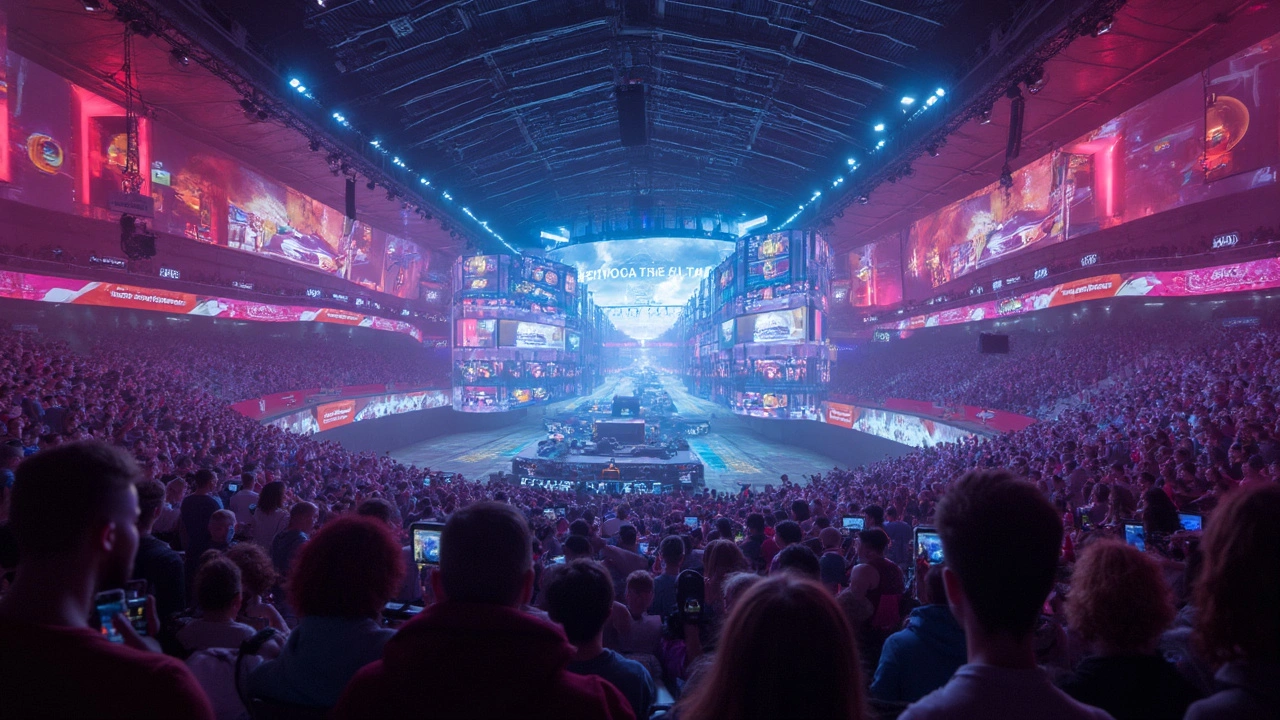Picture yourself racing down a virtual highway, laser-focused on the finish line, when a billboard catches your eye. But this isn’t some random ad thrown into your gameplay; it’s a sleek, dynamic image perfectly blended into the world, and it’s switched since the last time you played. Welcome to the new battleground for advertisers—in-game ads. Brands are now setting up shop directly inside your favorite games, sidestepping the traditional banner noise and connecting with millions in real time.
The Explosion of Gaming: A New Canvas for Advertisers
Gaming isn’t just for teens with too much free time. Seriously, check the numbers: in 2025, the global gaming industry pulled in over $215 billion, dwarfing movies and music combined. More people play games than watch Netflix or even scroll TikTok. But here’s the kicker—gamers aren’t bound to one demographic. Think young kids on tablets, parents squeezing in a match before bed, or retirees solving puzzles on their phones. Every month, nearly three billion people pick up a controller, a phone, or a keyboard and escape into digital worlds.
This massive, hyper-engaged audience offers a goldmine for brands. And unlike TV, viewers aren’t zoning out during commercials. In games, attention is intense and sustained. When someone’s playing, they’re not just looking—they’re totally locked in. This makes games the best arena for subtle ad integration. Brands spotted this early; Coke, Nike, and Samsung made appearances in blockbuster hits like FIFA and Fortnite years ago. But things have gone way past a logo slapped on a digital jersey. Now, we’re talking dynamic, programmatic, and data-driven placements that change with every login.
One wild example? In Animal Crossing during 2020, tons of brands popped up with virtual pop-ups in players’ villages. NBA 2K refreshes their in-stadium ads as current as cable TV. No movie theater on earth keeps up with that kind of pace. And because people are still wary of traditional pop-ups online, brands are going where ads don’t wreck the experience. “Native advertising” in gaming means blending seamlessly into a game’s world—you’re not yanked out of the story to watch a 30-second spot; the ad is just part of the world you’re already enjoying.
For marketers, the math isn’t rocket science. The more time people spend in-game, the more engagement you can grab—without irritating your audience. Traditional ad fatigue? Forget it. Well-done in-game placements are like Easter eggs, not interruptions. And as games scale globally, advertisers can tailor messaging by region, language, even player habits. China, for instance, leads the planet in gaming revenue, but the U.S., South Korea, and Brazil follow close behind. Ads can localize just as fast as gameplay updates do.
How In-Game Advertising Actually Works
What most people don’t realize is the complexity behind those natural-looking billboards or product placements. We’re far past static images coded in during development. Dynamic ad tech lets brands swap out ads in real time, much like websites show personalized banners. The heavy lifting is done by ad networks—think Bidstack, Anzu, or Admix. These tools plug right into a game’s engine, so the developer designs “ad spaces” within their levels. When you hit pause or fire up multiplayer, the network decides, based on tons of real-world factors, which ad you’ll see.
It’s wild how precise this is. Ever played FIFA and noticed the ads on the stadium hoardings? Those rotate live, depending on when and where you’re playing. In the U.S., you’ll probably see Taco Bell; in Europe, it might be Heineken. Sometimes, if you’re a first-time player, you’ll see a “Welcome” campaign, while longtime fans might get hit with something a bit more niche. The options here come down to several modes: static placements (logos on gear, vehicles, or clothing), dynamic ads (billboards, scoreboards, arena signage), or fully integrated story ads (think a special Mountain Dew mission in Call of Duty).
Programmatic advertising—the same tech behind those sneaker ads following you around Instagram—powers the most advanced in-game ads. Every impression can be counted, tracked, and rated for performance. Developers just carve out the space, and the ad tech fills it with whatever campaign lines up with users’ profiles. Since nothing needs patching or manual updates, this makes ads flexible and responsive. Say a game is suddenly trending in Brazil? Advertisers can react in hours, not months.
Data’s a big deal here. The beauty of in-game ads is the feedback loop. Ad platforms collect everything: how long a player glances at an ad, whether they interact, what route they take past it, how often they play, and even what time of day is hottest for engagement. That data, anonymized and stripped of sensitive info, feeds future campaigns. Targeting just got smarter—advertisers see what works and what bombs in real time, letting them bolder with creative risks or pull back before alienating anyone.
But this all hinges on one thing: invisibility. The greatest risk is shattering immersion. Companies have learned to work closely with game developers to ensure ads don’t stick out like a sore thumb. During a heated Rocket League match, a well-placed ad on the stadium wall fades into the action. In The Sims, consuming a real-world brand can feel like a cheeky bonus, not a forced product demo. It’s all about context and authenticity—when the ad adds to the world, players don’t mind.

The Business Side: Money, Metrics, and Models
Now, let’s talk cash. Game studios make massive investments up front, sometimes spending millions before their first player loads up. In-game ads give them a chance to monetize not just once at purchase, but ton by ton across the player’s entire journey. For developers, this means more revenue streams without nickeling and diming players for every skin or expansion pack. Ads keep titles free or cheaper, appealing to a much bigger crowd.
The revenue models vary. There’s cost per mille (CPM), paying for every thousand impressions; cost per click (CPC), where advertisers pay when users interact; or cost per action (CPA), which focuses on deep engagement like signing up or redeeming a code. Mobile games, in particular, love rewarded ads, where players watch content in exchange for in-game bonuses. Think of those times you watch a 30-second ad to get more coins or an extra life. It’s voluntary, and when done right, it’s a win-win.
Measuring ROI is another hot topic. Want to know how many players saw your ad during yesterday’s League of Legends tournament? Digital dashboards crunch the numbers instantly. Big publishers like EA or Ubisoft give brands “heat maps” showing where players spent most of their time, which ads landed, and which got ignored. There’s a level of analytics here that puts TV and billboards to shame. For example, a 2024 Unity survey showed in-game ads drove brand recall rates as high as 85%—almost double the numbers for standard digital display, and leagues ahead of old-school TV.
But don’t be fooled; sloppy integration can backfire, turning passionate fans into vocal critics. Gamers have torpedoed games on Steam or Reddit for overreaching with intrusive ads. Smart studios are learning—ads should never block progress, delay gameplay, or blast those tacky pop-ups that sent everyone running from mobile games a decade ago.
Privacy is another monster under the bed. Regulators in the EU, US, and Asia have begun sniffing around the kinds of data used for targeting. Developers walk a tightrope: harvest enough data for personalization, but don’t cross lines that make headlines. Seasoned pros encrypt and anonymize everything, upholding GDPR and CCPA standards. It’s why industry trust remains—and why the future is so lucrative for those who walk the line properly.
Creative Approaches: Lessons from the Trendsetters
The best in-game ads don’t scream “look at me!”; they become part of the story. Take Fortnite, for instance. Their Travis Scott concert wasn’t just ads—it was a crossover event that blended brand, experience, and gameplay. Over 12 million people tuned in live, and brand sponsors caught the kind of engagement you just don’t see anywhere else. That same year, Wendy’s inspired players to destroy in-game freezers, all to promote never-frozen beef—a viral success with millions of views, none of it built like your old banner ad.
Some games adopt a meta approach, making parody ads for fake brands, poking fun at real-world marketing while sneakily sliding genuine sponsorships in. Grand Theft Auto is a master here, mixing tongue-in-cheek billboards with low-key real products. It’s a wink and a nod—players love spotting the difference and sharing their finds on social media.
Mobile games excel at “rewarded ads.” Instead of forcing commercial breaks, they offer perks for voluntary viewing. Candy Crush players know the drill: watch a spot, gain a boost. The player feels in control, and engagement is higher when the choice feels theirs. A 2023 report by App Annie found that nearly 70% of mobile gamers preferred this style, and retention rates shot up when players viewed ads on their own terms.
Brands get savvier with branded missions, product-themed levels, and even exclusive unlocks tied to real-world products. Red Bull challenges in racing games, Apple Music playlists in sports titles, and real Nike gear for your avatar—these partnerships blur fiction and reality. When you win a virtual bottle of Gatorade after a marathon, you might just grab one in real life, too.
Don’t underestimate the influence of esports and gaming livestreams; Twitch, YouTube Gaming, and Facebook Gaming churn out billions of ad impressions every month. Sponsors get bonus exposure when in-game ads show up mid-broadcast, multiplying reach by piggybacking on influencers’ massive audiences. Suddenly, an ad seen by a gamer in Tokyo gets shared by a streamer in Paris and memed on Reddit within hours. The cycle continues, and brand value skyrockets.

What’s Next? Tips for Brands Wanting to Break In
This isn’t just about dropping a JPEG into a game and calling it innovation. For brands ready to take the leap, a few lessons are key. First, respect the player experience. Ads work best when they fit the vibe; a gritty shooter needs different sponsors than a racing sim or a family puzzler. Collaborate closely with developers, not just ad tech vendors. If it feels out of place, players will talk—and it won’t be pretty.
Stay dynamic. The best campaigns use up-to-the-second data to tailor messages. Test, tweak, analyze—dump the stuff that flops, double down on winners. If you’re running a holiday campaign, make adjustments minute by minute, not campaign by campaign. Geo-target, age-target, even personalize by skill level or play style where possible.
Don’t forget about cross-channel synergy. The smartest brands sync in-game ads with social pushes, influencer events, or exclusive in-game content drops. Picture a sneaker launch: show the ad in-game, then have streamers show off exclusive unlocks, and fans share their “finds” on TikTok. This kind of echo chamber pumps up brand visibility way past the initial impression.
Analytics are everything. Before you slap your logo inside the next big title, figure out what you’re measuring—not just views, but actual engagement, shares, social mentions, and purchase intent. Establish a clear feedback cycle with both your ad tech partner and the game devs. If players hate the campaign, know why. If they love it, consider sequels or special events.
Finally, never lose sight of privacy. The laws are changing quickly, and gamer distrust destroys reputations fast. Work with partners who are transparent about data, honor opt-outs, and don’t overreach. If you can pull off a smart, sensitive campaign, you’ll unlock a wave of loyalty—and profit—in this massive, fast-growing world.
Ready or not, this is the new era. In-game ads aren’t just the sideshow anymore—they’re the main event. Miss out now, and your brand could be forgotten on the loading screen.


I'm a Marketing Expert with over a decade of experience in the industry. I specialise mainly in online marketing and have worked with numerous global brands to elevate their online presence, build their brand image, and increase their sales. My passion lies in creating meaningful and engaging campaigns that truly resonate with audiences. In my spare time, I enjoy sharing my knowledge and experiences through my blog where I primarily write about the latest trends and tricks in online marketing.